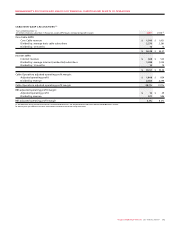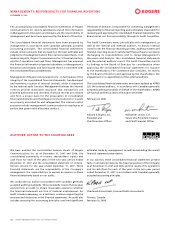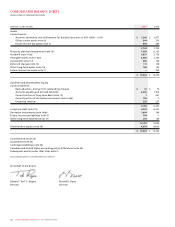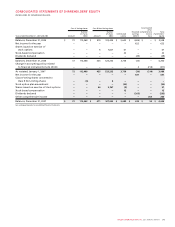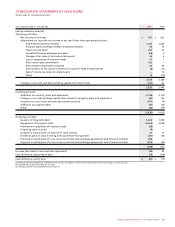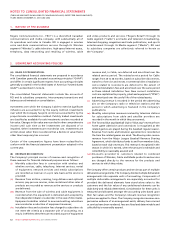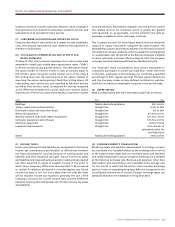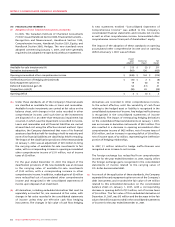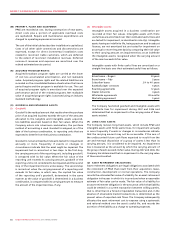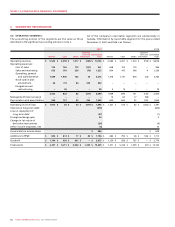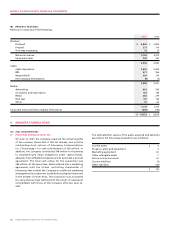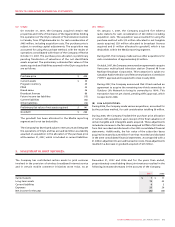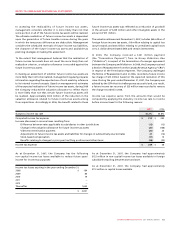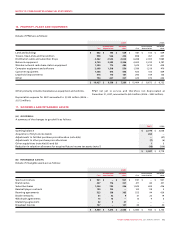Rogers 2007 Annual Report Download - page 89
Download and view the complete annual report
Please find page 89 of the 2007 Rogers annual report below. You can navigate through the pages in the report by either clicking on the pages listed below, or by using the keyword search tool below to find specific information within the annual report.
ROGERS COMMUNICATIONS INC. 2007 ANNUAL REPORT 85
NOTES TO CONSOLIDATED FINANCIAL STATEMENTS
(J) INVENTORIES AND ROGERS RETAIL RENTAL INVENTORY:
Inventories are primarily valued at the lower of cost, determined
on a first-in, first-out basis, and net realizable value. Rogers Retail
rental inventory, which includes videocassettes, DVDs and video
games, is amortized to its estimated residual value. The residual
value of Rogers Retail rental inventory is recorded as a charge to
operating expense upon the sale of Rogers Retail rental inventory.
Amortization of Rogers Retail rental inventory is charged to cost of
sales on a diminishing-balance basis over a six month period.
In 2007, the CICA issued Handbook Section 3031, Inventories
(“CICA 3031”). CICA 3031 aligns Canadian GAAP with International
Financial Reporting Standards (“IFRS”) and establishes the principles
for measurement, recognition and disclosure of inventories. The
Company adopted this new standard effective January 1, 2007,
retrospectively without restatement. The application of this
standard did not have a material impact on the consolidated
financial statements of the Company.
(K) DEFERRED CHARGES:
The direct costs paid to lenders to obtain revolving credit facilities
are deferred and amortized on a straight-line basis over the life of
the debt to which they relate.
During the development and pre-operating phases of new products
and businesses, related incremental costs are deferred and amortized
on a straight-line basis over periods of up to five years.
(L) PENSION BENEFITS:
The Company accrues its pension plan obligations as employees
render the services necessary to earn the pension. The Company
uses the current settlement discount rate to measure the accrued
pension benefit obligation and uses the corridor method to amortize
actuarial gains or losses (such as changes in actuarial assumptions
and experience gains or losses) over the average remaining service
life of the employees. Under the corridor method, amortization
is recorded only if the accumulated net actuarial gains or losses
exceed 10% of the greater of accrued pension benefit obligation
and the fair value of the plan assets at the beginning of the year.
The Company uses the following methods and assumptions for
pension accounting:
(i) The cost of pensions is actuarially determined using
the projected benefit method prorated on service and
management’s best estimate of expected plan investment
performance, salary escalation, compensation levels at the
time of retirement and retirement ages of employees. Changes
in these assumptions would impact future pension expense.
(ii) For the purpose of calculating the expected return on plan
assets, those assets are valued at fair value.
(iii) Past service costs from plan amendments are amortized on a
straight-line basis over the average remaining service period
of employees.
(D) The Company reviewed significant contracts entered into
on or after January 1, 2003 and determined there are no
significant non-financial derivatives that require separate fair
value recognition on the consolidated balance sheet on the
transition date and at December 31, 2007.
(E) The unamortized deferred transitional gain of $54 million at
December 31, 2006, which arose on the change from marked-
to-market accounting to hedge accounting that was calculated
as at July 1, 2004, was eliminated upon adoption, the impact of
which was a decrease to opening deficit of $37 million, net of
income taxes of $17 million.
(F) Effective January 1, 2007, the Company records all transaction
costs for financial assets and financial liabilities in the
consolidated statements of income as incurred. The Company
had previously deferred these costs and amortized them over
the term of the related asset or liability. The carrying value of
transaction costs at December 31, 2006, of $39 million, net of
income taxes of $20 million, was charged to opening deficit on
transition on January 1, 2007.
(ii) Derivative instruments:
The Company uses derivative financial instruments to manage
risks from fluctuations in exchange rates and interest rates.
These instruments include cross-currency interest rate
exchange agreements, interest rate exchange agreements,
foreign exchange forward contracts and, from time to time,
foreign exchange option agreements. All such instruments are
only used for risk management purposes.
When hedge accounting is applied, the Company formally
documents the relationship between derivative instruments
and the hedged items, as well as its risk management objective
and strategy for undertaking various hedge transactions. At
the instrument’s inception, the Company also formally assesses
whether the derivatives are highly effective at reducing or
modifying interest rate or foreign exchange risk related to
the future anticipated interest and principal cash outflows
associated with the hedged item. Effectiveness requires a high
correlation of changes in fair values or cash flows between the
hedged item and the hedging item. On a quarterly basis, the
Company confirms that the derivative instruments continue to
be highly effective at reducing or modifying interest rate or
foreign exchange risk associated with the hedged items.
For those instruments that do not meet the above criteria,
changes in their fair value are recorded in the consolidated
statements of income.
(I) NET INCOME PER SHARE:
The diluted net income per share calculation considers the impact
of employee stock options using the treasury stock method. There
is no dilutive impact of employee stock options after May 28, 2007,
due to the amendment to attach cash settled SARs to all new and
previously granted options.


